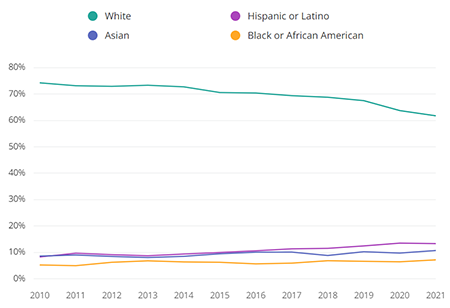
THE ONLINE HOME FOR CO 4713 MULTIMEDIA JOURNALISM
editor in chief / instructor of record : wendy roussin, mfa
Christopher Gent. Diversity in Content Creation
Big Beginnings
Social Media is one of the most influential inventions ever created. Being able to instantly communicate with people from different cities, states, nations, and even continents has changed the world entirely. And with the rise of social media throughout the years, a new job has appeared in the market. Content creation became an occupation that allowed people to make a living based on their interests and personalities. As long as one has the internet, they have the capability of having a job on social media, regardless of one’s look. Whether someone is black, white, Asian, Hispanic, man, or woman doesn't matter when it comes to making a living on social media.
Influencing
According to the SearchEngineJournal, YouTube is the second most popular social media site, with nearly 2.5 billion users. By having close to a third of the Earth’s population, it should come as no surprise that YouTube has such a diverse field of both creators and viewers. Since its inception, Jenna Marbles and KSI pioneered and broken barriers for women and black creators.
Cameron Bryant, a senior Biological Sciences major, said that black people in content creation feel empowered. “I would say that it’s nice to see black people in content creation circles because it makes me feel like ‘we’ can do it too,” said Bryant. Bryant would not be the only one with this sentiment, as thinkwithgoogle.com says that over 2/3s of black millennials feel that YouTube is a place where black people have a voice.
Additionally, other races have also been becoming more prevalent in the field. Although this chart only depicts the population of content creators in the US, the amount of White creators has gone down, while the other races have begun to move up, with the Hispanic community growing the most from 8 to 13 percent.
source: zippia.com

Toxicity Rising
One of the most important aspects of any business is the audience, and for content creation, it’s no exception. The audience matters because, without them, there is no way content creators can make a living. And while there are people on the internet that can find and relate to creators that do not show their face, or look completely different from said viewer, there is also a portion of viewers who do not share the same courtesy.
The Influencer Marketing Hub reports that over half of online content creators have felt that they have suffered some type of discrimination, and it’s easy to see why. Since many social media platforms allow for anonymity, this tends to allow people to express their opinions without any repercussions. Additionally, these views can be dangerous and extreme. Even though plenty of platforms have some forms of filters to mute, censor, or remove hateful comments and slurs, that does not stop commenters who will and have found multiple ways to get around said filters.
These comments can be traced to racism, misogyny, xenophobia, Islamophobia, etc. but the fact is that regulating the internet globally is nearly impossible to do. Anonymity has allowed people to get away with hateful comments because nothing can be done to severely punish them. Muting or blocking comments seems like a simple solution, but that can also backfire. The person who got blocked can let other hateful-minded people know about the blocking, and send them over to the creator. Additionally, the blocked commenter can make more accounts and keep sending hate. As mentioned earlier, filters set by the platforms are set, but there are multiple ways that people get around them, such as using emojis or creating new slang.
Another possible solution could be for a creator to not show their face. This is an option that some creators go for. Whether it be for privacy, insecurity, or safety reasons, creating content without showing one’s identity is one way that people create content. However, that does not mean they are safe from criticism. People can still hate creators through their voices. Additionally, from a business perspective, making content without a face-cam, is not the most viable option, as a study from Adwerx says that 92% of ads do better when they include a face. While ads and content are different, it seems safe to assume that there could also be a correlation for content that shows someone’s face, but not to the extent of 92%.
The Impact of Diversity in Content Creation

Diversity matters in content creation. It is important to highlight that people from all walks of life exist in the world. It also important for the younger generation. Since nearly 1/6th of kids today watch YouTube, just seeing those diverse creators will help them make a difference. Young children’s racial beliefs are heavily influenced by their environment.
The best way for diverse creators to combat toxicity is to keep moving forward. This is much easier said than done, but since there are no real ways to properly regulate the internet, this seems to be the best solution. By moving forward, these creators will publicly show that the toxicity is not an obstacle, while also giving the younger generations inspiration. This will keep building as the younger diverse generations eventually get older and become creators that continue the cycle. By doing this, the diverse creators will not be seen as diverse creators, but seen as creators. It is impossible to escape toxicity based on appearances, bigotry will always exist. But as long as there are those who push past those obstacles, they will continue to open up the path for those like them to follow suit.
View my Sources
Email me at cag634@msstate.edu with any questions